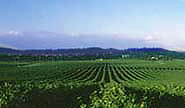Cowra
Introduction
Until 1973, when Cowra Estate planted the first vines in the region, Cowra was best known as the site of Australia's prisoner of war camp for Japanese soldiers and citizens. It was also the scene for a futile mass escape, and today has an attractive memorial garden and museum recording the events of those days.
To this day, the rolling hills with their sweeping vistas are predominantly given over to grazing. But since 1973, Cowra has grown enormously in importance as a region, even if growth has come in sporadic bursts.
The 1990s saw a major expansion, with a number of larger companies (notably Rothbury and Orlando's Richmond Grove) and boutiques such as Brokenwood aggressively planting vineyards. It is primarily a white wine region specialising in full-flavoured, modestly priced Chardonnay.
The vineyards are situated on gentle slopes within a broad valley cut into the western side of the Great Dividing Range by the head waters of the Lachlan and Belubula rivers, which converge into the Lachlan at Gooloogong, flowing into the Murrumbidgee River north of Balranald.
After a hesitant period, several wineries are now operating in the region, with more planned for the first few years of the new century.
For practical reasons, and given the rate of growth in plantings spreading out to Canowindra, it is only a question of time before Cowra emerges as a fully fledged region with an increasing number of wineries and cellar-door operations which draw tourists, in turn creating demand for more accommodation and tourist infrastructure of all kinds.
The number of wineries (or brands with cellar door operations based solely on Cowra-grown fruit) has increased dramatically, now including Cowra Estate, Danbury Estate, Hamiltons Bluff, Kalari Vineyards, Mulligan Wongara Vineyard, Tom's Waterhole Wines, Wallington Wines and Windowrie Estate. In addition Arrowfield, Brokenwood, Charles Sturt University, Hungerford Hill, Richmond Grove and Rothbury all have Cowra-region branded wines in their portfolio.
Region Summary
 Location and Elevation
Location and Elevation
Central Ranges Zone
33°57'S, 148°40'E
300-380 m
Subregions
None
Climate
The climate is hot and dry, with the Mean January Temperature variously recorded between 23.5°C and 24.4°C, significantly above that of Cessnock (Hunter Valley) or Mudgee. Growing season rainfall is relatively high, but relative humidity is low, reflecting the continental nature of the climate. Spring frosts require appropriate site selection.
Statistics
Heat degree days: 2130
Sunshine hours per day: 8
Annual rainfall: 640 mm
Growing season rainfall: 350 mm
Mean January temperature: 23.8°C
Harvest: Early March?early April
Soil
The soils are those most commonly found throughout southeast Australia; brownish loamy sand to clay loam on the surface, with red clay subsoils. They are moderately acidic, and likewise moderately fertile.
Principal Grape Varieties
Chardonnay: 5352 tonnes
Semillon: 760 tonnes
Verdelho: 539 tonnes
Sauvignon blanc: 266 tonnes
Other: 169 tonnes
Total white: 7086 tonnes
Shiraz: 2280 tonnes
Cabernet sauvignon: 1088 tonnes
Merlot: 322 tonnes
Pinot noir: 309 tonnes
Cabernet franc: 211 tonnes
Other: 40 tonnes
Total red: 4250 tonnes
Total: 11 336 tonnes
(NSW Winegrape Utilisation Survey estimates for 2001 vintage )
Principal Wine Styles
Chardonnay
By far the most important wine of the region, invariably generously flavoured and, in most instances, relatively quick maturing. However, Petaluma Chardonnays from the late 1970s and the freak Rothbury Estate 1981 Cowra Chardonnay (in particular) demonstrated a largely unrecognised capacity to develop into ultra-rich, golden, honey and buttered toast styles. In younger wines, yellow peach and ripe fig flavours tend to dominate; by the nature of things, a degree of American oak influence is commonplace.
Other White Wines
Sauvignon Blanc, Verdelho, Riesling and Gewurztraminer are the most commonly encountered white wines with both variety and region specified on the label. Semillon and Verdelho show most promise.
Red Wines
Cabernet Sauvignon, Shiraz, Pinot Noir, Merlot and Cabernet Franc have all been made from time to time, the former two being more suited to the region than the latter. The wines are pleasantly soft and easily accessible.
by James Halliday
